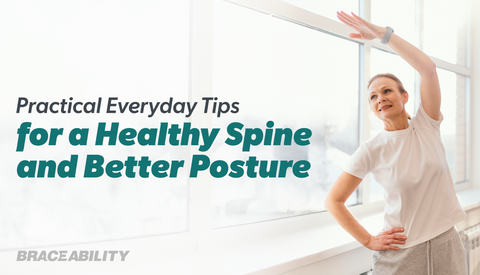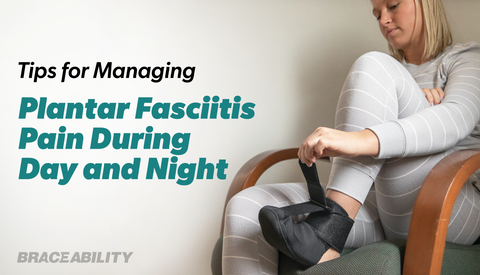Achilles Tendonitis | Causes & Treatments
What is Achilles Tendonitis?
This condition’s origins are heroic in nature. According to Greek mythology, Achilles was a Greek hero of the Trojan War whose only vulnerability (and ultimate downfall) was the back of his heel. These origins have resulted in the term “Achilles’ heel” being synonymous with one’s ultimate weakness.
The story and reference speak to how vital the tissues at the back of your leg near the ankle that connect the calf muscles to the heel bone are. Indeed, the Achilles is the thickest and strongest tendon in the body and it plays a vital role in enabling one to walk, run, jump or stretch onto one’s toes to reach something on the top shelf.
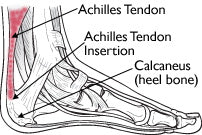
What Causes Achilles Tendonitis?
What sort of activity weakens this mighty tendon? In short, overuse or degeneration that causes Achilles tendonitis pain. More specifically, a sudden increase in activity (especially running) or sporadic engagement in sports can damage this tendon.
There are two types of Achilles tendonitis that are differentiated by the part of the Achilles tendon that is affected:
Noninsertional Achilles Tendonitis affects the middle part of the tendon.
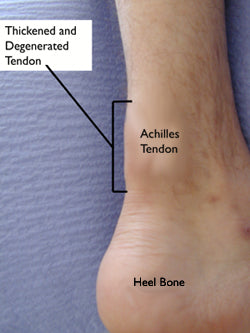
Insertional Achilles Tendonitis
Insertional Achilles Tendonitis affects the lower part of the heel where the tendon attaches to the heel bone.
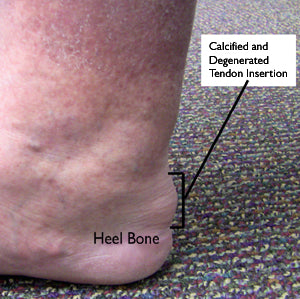
One’s workout conditions can also be influential in the condition’s onset, as shoes without proper heel cushion or arch support can be detrimental, as can hilly terrain or cold weather. On a related note, tight calf muscles can also make one more prone to Achilles tendonitis.
Other physical conditions that can increase one’s likelihood to develop Achilles tendonitis are obesity or flat feet. Also, frequent switches between shoe height extremes (Think high heels to workout shoes) can also wear on the Achilles.
The condition is found more often in middle-aged men as the tendon will weaken with age.
Certain medications (fluoroquinolones) and medical conditions (diabetes, high blood pressure) can also raise one’s likelihood of suffering from Achilles tendonitis.
Symptoms of Achilles Tendonitis
Achilles tendonitis comes on gradually, starting as an ache above the heel following athletic activity that becomes more intense as time progresses. When one gets up in the morning, the region where the Achilles tendon is located may feel tender or stiff, but that generally improves as the foot limbers up from moving around.
The pain will become more severe after extended periods doing activities that are particularly stressful to the region, such as sprinting or climbing stairs.
It is important not to ignore persistent pain, as it can be a sign of rupture or tears to the Achilles tendon, which can only be repaired by surgery. And even if that is not the case, it is important to address the pain because Achilles tendonitis makes a rupture or tear more likely because it weakens the tendon.
How to Heal Achilles Tendonitis Noninvasively
Unlike a tear to the tendon, treatment of Achilles tendonitis usually involves relatively noninvasive measures. The best treatment for Achilles tendonitis, or certainly the go-to remedy for healing Achilles tendonitis is rest. One should avoid the activities that brought on this painful condition and, if possible, switch to a less stressful sport such as swimming during the healing process.
Icing the affected region to reduce inflammation is another simple way to treat Achilles tendonitis. Taking over-the-counter medication to reduce pain and inflammation, such as ibuprofen or naproxen, may also help.
Another form of Achilles tendonitis rehab exercises and stretches aimed at lengthening and strengthening the Achilles tendon and associated muscles.
A doctor or physical therapist may also recommend a variety of orthotics for Achilles heel tendonitis treatment; Achilles tendonitis braces, night splints or boots can help reduce inflammation, ease pain and speed the healing process.
Shockwave therapy is sometimes used for Achilles tendonitis treatment. This Achilles tendonitis rehabilitation method is undergone with the goal that shockwaves will stimulate healing in the damaged tendon tissue.
Invasive Achilles Tendonitis Treatments
A cortisone shot is sometimes used as a the treatment for chronic Achilles tendonitis, but the fact that these injections can cause the Achilles tendon to rupture means this is a rarely recommended treatment option.
If other treatment methods fail, a doctor might recommend surgery for chronic Achilles tendonitis treatment; during the Achilles tendonitis recovery period, a rehab brace may be recommended.
Achilles Tendonitis Prevention
Ultimately, the best thing you can do for Achilles tendonitis is to engage in practices that prevent it from occurring or reoccurring. Many Achilles tendonitis prevention methods are closely tied to the aforementioned causes of Achilles tendonitis. The Mayo Clinic recommends the following preventative actions:
- Increase activity levels gradually
- Avoid activities that put inordinate stress on the Achilles tendon
- Alternate between high and low-impact activities
- Stretch your calf muscles and Achilles tendon daily
- Strengthen your calf muscles to help them better withstand stress
- Wear shoes with good support
Source: American Academy of Orthopedic Surgeons, https://orthoinfo.aaos.org/en/diseases--conditions/achilles-tendinitis








